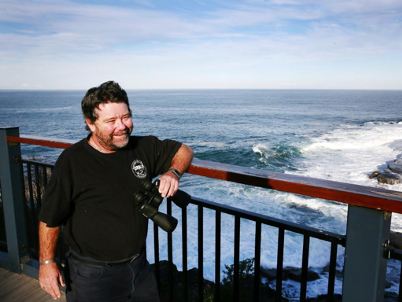The moving spectacle of thousands of Humpbacks, Southern Right and other whale species is something we should all experience at least once in a lifetime. You will find yourself left in awe by their size and beauty and this wonderful migration.
From May to November there is chance to see these majestic creatures up close from many raised outlooks along the NSW coast. Towards the end of the autumn months they begin their migration north from the Southern Ocean of Antartica to warmer waters of the Pacific to breed and calve. Whale calves are born without the protective fat layer, known as blubber, to keep the calves insulated. The calves would die if they were born in the freezing water temperatures of the Antarctic. In the spring they return south once the calves have put on weight. The whale population in the southern hemisphere spends the summer months feeding. Over 30,000 whales are predicted to be currently migrating!
Once you see a whale, there is a chance you will see it display any of the following behaviours
- Breaching – where all or most of the whales body leaves the water.
- Blowing – where a whale blows air, water vapour and mucus as they surface to take a breath of air.
- Lobtailing or tail slapping – where the whale lifts its tail flukes out of the water and then slaps them down onto the surface of the water.
- Spy hopping – where a whale lifts their head and part of their chest vertically out of the water so their eyes are just above the water line.
There are numerous scenic coastal lookouts and walking tracks from which nature lovers can go to. Whale watchers can download NPWS free Wild About Wales mobile app to find vantage points and notifications of nearby sightings. Whale Count Days are held in June at certain locations including Cape Byron, Port Macquarie, Sydney and the Central Coast.
Here are some of the best places to see these majestic giants, be sure to take binoculars, hiking shoes, snacks and a picnic!
1. Eden

Top Viewpoint: – Green Cape Lookout in Ben Boyd National Park.
Other Viewpoints: – Bunga Head and Wajurda Point in Mimosa Rocks National Park.
Captivating coastal scenery alongside an intriguing Aboriginal and whaling heritage await you in the town of Eden. Steeped in whaling history, Eden is bordered by rocky cliffs on one side and national park on the other. This Sapphire Coast area in NSW is one of the few places to see whales feed.
Green Cape is a headland about 40km south of Eden in Ben Boyd National Park, forming the northern head of Disaster Bay. The lookout is at the point of Green Cape and provides great views out to sea to spot whales. In Mimosa Rocks National Park, the Wajurda Point walking track leads to a lookout offering spectacular ocean views and a great spot for whale watching during winter and spring.
The first humpbacks can be seen making their annual journey to the warm waters near Queensland between June and August. Then between September and November you will be able to catch sight of mothers and calves as they return to Antarctica. Humpback whales travel in large numbers and stay close to shore with their young. You may also be lucky enough to spot Sperm whales, Minke whales and Orcas further off the coast. Whale watchers are reminded to stay safe during the season by keeping a safe distance away from rock platforms, cliff edges, coastal walks and lookouts.
The details of the history of whaling in the area, can be found at the Killer Whale Museum. The skeleton of the most famous killer whale ‘Old Tom’ is displayed there as well as exhibits of the maritime and whaling industry. Every year in November the rich maritime and whaling history of Eden port becomes the centrepiece for the Eden Whale Festival.
2. Port Stephens

Top Viewpoint: -Tomaree Head Summit in Tomaree National Park.
Other Viewpoints: – Fishermans Bay foreshore in Tomaree National Park. Sugarloaf Point Lighthouse in Myall Lakes National Park.
Port Stephens is a perfect combination of wildlife and nature based activities. High dunes, rocky headlands, coastal rainforest and National Parks, gives the region another dimension to the whale watching. Humpback and Southern Right Whales are the most common with the occasional sighting of Minke, False Killer Whales (an Oceanic Dolphin) and Orcas. Between June and August the whales are on the annual northern migration and return south between September and November. Humpback mothers and their new born calves are easily spotted from Tomaree Head in spring. Look for the ‘V’ shaped puff of spray as the whale surfaces, you might even see these acrobatic whales do tail slaps, pectoral fin waves, body rolls and the wondrous ‘breach’.

The summit of Tomaree Head, 161m above sea level and both the north and the south platform will give panoramic views over the ocean for whale spotting. Sugarloaf Point Lighthouse stands on dramatic headland east of Seal Rocks village and is a top spot for watching whales as they migrate on their annual journey along the coast.
The region is home to pods of Bottlenose Dolphins, Koalas and a little Penguin breeding colony. The 26 golden sandy beaches in the Port Stephens area give plenty of opportunity for coastal walking as well as bushwalking and other nature based activities.
3. Sydney and Surrounds

Top Viewpoint: – Barrenjoey Headland at Palm Beach on Sydney’s Northern Beaches, situated as Sydney’s most northern point in Ku-ring-gai Chase National Park, 91m above sea level.
Other Viewpoints: – South Head at Watsons Bay, Solander in Kamay Botany Bay National Park, Fairfax Lookout North Head.
From the east of the small peninsula of Barrenjoey Headland is a vast stretch of the Pacific Ocean, giving opportunities to see whales. Barrenjoey Lighthouse lies at the furthest point can be reached by either of two tracks. The tracks are well marked after parking at the far northern end of Governor Phillip car park. The shorter Smugglers Track is a harder hike but has sensational views down over Palm Beach and Pittwater. The lighthouse historically retaining its original sandstone finish from the 1800s and stands 113m above sea level and is a perfect spot for spotting whales.
The distinctive red-and-white striped Hornby Lighthouse has no shortage of lookouts. The area is known for its steep ocean cliffs and an even better spot is the Gap, an ocean cliff on the South Head peninsula. As you climb to the top to look over the Tasman Sea and Sydney Harbour you have a spectacular view to spot a whale. The 1km loop from the Lighthouse to the Gap takes one hour to complete. Cape Solander is where Sydney’s whale count takes place. It has some of the most amazing views of the Sydney coastline with a gorgeous clifftop walk with vast ocean and heathland views. Fairfax Headland standing at 80m high is the furthest east of all of southern Sydney and you can see whales coming for miles. There you will also get incredible views south along the cliffs to Bondi and beyond.
Sydney and the surrounding coastline offers opportunities to see whales migrating even from the iconic harbour. These huge mammals weigh around 30,000kg and get their name from their hump shaped pectoral fins and head. Capable of travelling 8km an hour they average a journey of only 2km before they stop, rest socialise and play. Whales have been known to swim as close to 200m from the coast.
4. Coffs Harbour Region

Top Viewpoint: – Woolgooga Headland, Coffs Coast Region, easy vehicle access and extensive views over Solitary Islands.
Other Viewpoints: – Sawtell Beach and headlands. Muttonbird Island. Bundegen Head in Bongil Bongil National Park
Woolgoolga Headland with its sweeping views over the coast and Solitary Islands is a great spot for whale watching in the Coffs region. Discover pristine beaches, unbeatable surf, vast views and opportunities to see whales. From mid-May you can spot Southern Right Whales and from the beginning of June for Humpbacks as they make their Northern migration to breed in the tropics. Then from mid-September through to November as they return to the Antarctic feeding grounds. The walkway joining the viewing platform at Woolgoolga headland to Woolgoolga Beach enhances the existing Solitary Island Coastal Walk with more viewing platforms and signs to inform visitors about whales and whale migration.

The Solitary Islands Marine Park covers a total of 71,000 hectares and extends along 75km of coast. Here Humpback whales can be spotted on their migration from Antarctica and are often sighted spouting and doing tail slaps a few of kilometres from the harbour. The headlands at Sawtell Beach gives a wonderful view at the top and worth the walk up to get such a good vantage point. Muttonbird Island known as Giidayn Miiral or ‘moon sacred place’ known by local Gumbaynggirr people and has much Aboriginal significance. Head to the island’s peak or eastern side to look for migrating whales. Bundegen Head Bongil Bongil National Park, just near Coff’s Harbour, is perfect for spotting whales.
5. Jervis Bay
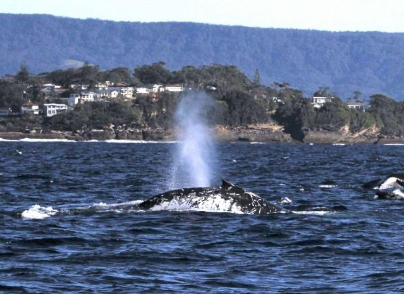
Top Viewpoint: – Seven Mile Beach National Park
Other Viewpoints: – Crookhaven Heads and Penguin Head at Culburra Beach, Warden Head Lighthouse in Ulladulla, Point Perpendicular, Bull Hole Lookout in Jervis Bay National Park.
Jervis Bay marks the halfway point of the 5,000km whale migration path and so experiences a lengthy whale watching season from May to November each year. It is the only place in NSW where the waters are calm so close to shore. The whales use the area as a place to rest and play with their newborn calves. Visitors can spot a variety of different whale species including Humpback, Southern Rights, Minkes, Orcas and Pilots.
Seven Mile Beach National Park not only offers many great viewing spots for whale watching but also means it is you can take the family fishing, swimming, picnicking and explore many walking tracks. Both the viewing platforms at either end of Culbarra Beach showcase the seascape that stretches all the way to Currarong in the south and Shoalhaven Heads in the north. Warden Head Lighthouse in Ulladulla looks over some very rugged coastline and it is possible to see the whales very near to the shore from this vantage point. There are also a variety of walking tracks that lead to tall headlands again giving spectacular viewpoints. Point Perpendicular Lighthouse provides sweeping views of Jervis Bay where female wales and their calves frolic among the crystal clear waters. The whole area is renowned for its Aboriginal heritage with Booderee Botanic Gardens being the only Aboriginal owned botanic gardens in Australia and worth a visit.
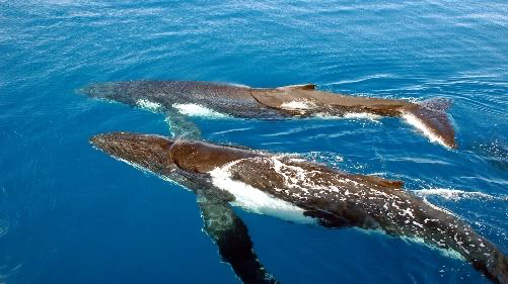
6. Byron and Tweed
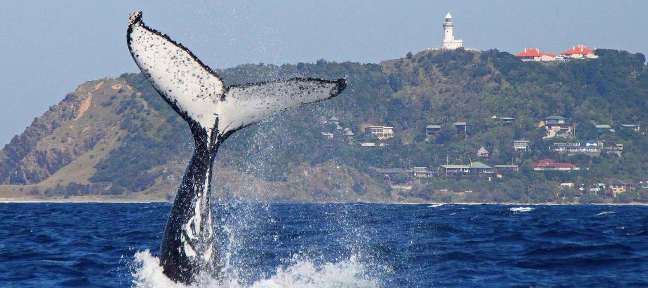
Top Viewpoint: – Cape Byron Lighthouse
Other Viewpoints: – Broken Head Nature Reserve, Three Sisters, Iluka Bluff lookout, Tweed Heads
Byron Bay is a holiday hotspot and whale watching hotspot too! Spotting whales before or after they cross the Queensland waters during May to November is a popular pursuit for residents and visitors alike. Cape Byron sits at Australia’s easternmost point and is a renowned sighting spot to see whales splashing about. The strip of coast between Tweed Heads and Byron is inundated with pods of humpbacks, dolphins and turtles who also migrate through this way. At Cape Byron Lighthouse, even if the whales are not being cooperative you will get magnificent headlands and glittering ocean views. The history around the Lighthouse and the whale’s migration can be enjoyed at the Maritime Museum which is well worth a visit, as well as wandering along the Cape Byron walking track to see breaching humpbacks along the way. The famous white whale Migaloo has be spotted swimming off Byron Bay’s coast as well as other places in NSW.
Broken Head Nature Reserve is nearby and again offers great whale watching opportunities. Three Sisters close by offers more whale watching chances as well as being a place of important Aboriginal cultural heritage. Iluka Bluff lookout near Evans Head is another good spot to view whales. As you head to Tweed Heads make the most of the lookout at Point Danger as migrating whales often swim close to the shore here. Tweed, Ballina and Byron Bay all lie on Australia’s legendary Pacific Coast between Sydney and Brisbane.
7. Port Macquarie
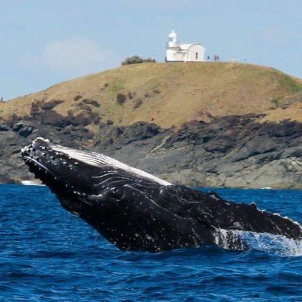
Top Viewpoint: – Smoky Cape Lighthouse in Hat Head National Park.
Other Viewpoints: – Perpendicular Point and Charles Hamey lookout in Kattang Tacking Point Lighthouse, Diamond Head and Mermaid lookout at Crowdy Bay, Port Macquarie coastal walk, Grants Head at the northern end of Grants Beach.
As the second most easterly point in NSW, Port Macquarie’s 9km Coastal Walk is dotted with vantage points perfect for whale spotting. The most common encounters are with Humpback whales as they breach – rise through the surface of the water and turn while in the air. In days gone by these majestic creatures where used for their blubber which was melted down to be used as oil for lamp fuel, lubricants candles and as a base for soaps and perfumes. The Southern Right whales can also be sighted with their two blowholes as they exhale in a distinctive V-shaped plume up to five metres. Adults are 14-18 metres long a similar length to Humpback whales and are known for swimming into shallow bays. Both Southern Rights and Humpbacks are known for spy-hopping as they raise their heads out of the water and hold in a vertical position for a moment as they look around. Tail slapping is another similar trait in both species and is when a whale lifts its fluke-tail-out of the water then slaps it against the water.
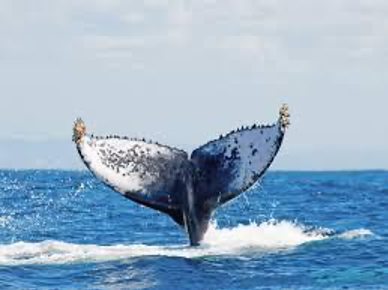
Port Macquarie’s 9km Coastal Walk from Town Beach to the Tacking Point Lighthouse is scattered with stunning vantage points and a number of seats along the way to enjoy whale watching. As you walk along the coastline you will see several historical sites and discover stories of Aboriginal heritage. The historic Smoky Cape Lighthouse has Captain Cook’s lookout nearby from which you can spot whales in the glistening waters. At Perpendicular Point in Kattang Nature Reserve is offers a great outlook for spotting whales The Perpendicular Point stands tall with 40m vertical cliffs plummeting to the sea below and giving breathtaking views of ocean and coastline. At the Charles Hamey lookout you can gaze across the golden sands of Dunbogan Beach as it sweeps around to Diamond Head at Crowdy Bay National Park and lookout for whales in the glistening blue waters below. Mermaid lookout track takes you on a tour of Crowdy Bay National Park’s surprises of secluded coves, sweeping beaches and mountain views and is a great spot for whale watching.
8. Batemans Bay
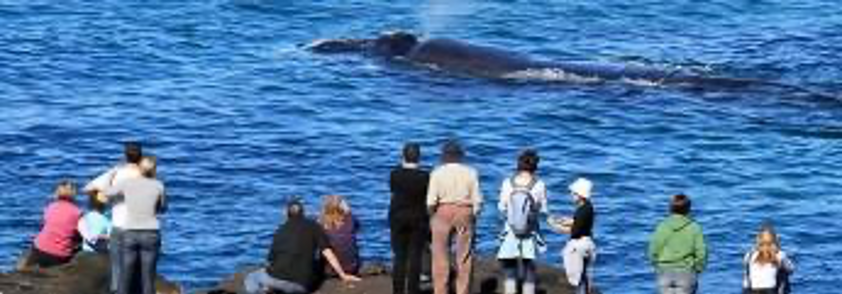
Top Viewpoint: – Depot Beach Murramarang National Park
Other Viewpoints: – North Head lookout, Meroo Head lookout – Meroo National Park, , Nuggan Point, South Head
Whales typically pass Narooma as they head north in June and July but it is from September to November that you are treated to a whale-fest and are most certain to view these giants. Whale spotting in the Bateman Bay area it is much easier when they swim south on their return trip, as some come within 3km from land. During their northern migration the animals seem to move further offshore. Leading vantage points and panoramic views are in Marramarang National Park and Meroo National Park which are within an easy driving distance from Batemans Bay. The spectacular cliffs along the Murramarang coastline make a superb spot for whale watching and spectacular coastal vistas. The views from Meroo Head lookout are not to be missed and while visiting Meroo National Park, follow the walking track to Nuggan Point for more places to keep an eye out for whales. South Head is a secluded headland with two small clearings, one to the north and one to the south. Both can be accessed by a short walk along path at the end of Tallawang Avenue, Malua Bay.
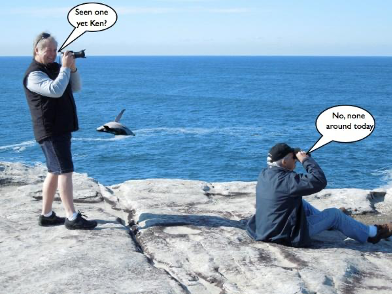
It is not always a spout that signals a whale surfacing, as changing light and wind conditions can make it hard to see. Watch for an unusual splash or a shiny reflection of a dorsal fin. A breaching whale will be clearly seen but a steady cruising pod may be a little harder to locate. Some whale watchers say that a change in wind can turn previously quiet humpbacks to acrobatic athletes. So, if the breeze suddenly changes direction of increases in intensity be vigilant and bring binoculars!
9. Newcastle area
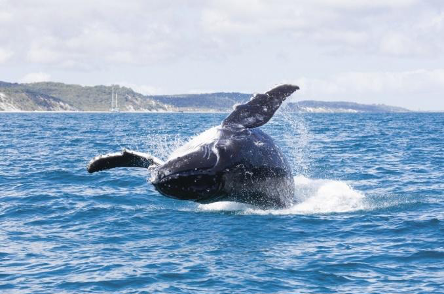
Top Viewpoint: – Nobby’s Headland
Other Viewpoints: – Redhead Bluff, Shepherds Hill Lookout, Caves Beach Walk, Merewether Beach
The well-known Nobby’s Headland is at the southern entrance to Newcastle Harbour and offers the area’s furthest views over the Pacific by having a 360-degree view of Newcastle and the surrounding coast. The magnificent site of the majestic whales migrating is a site to behold and the Lighthouse there is a perfect place for whale watching. Overlooking the city of Newcastle is Shepherd’s lookout and another popular place to watch the whales go by. The prime location of Redhead Bluff is a red rocky headland that offers views that stretch across the ocean and south over Nine Mile Beach towards Blacksmiths and Swansea.
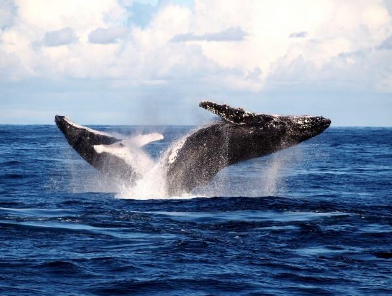
The whale watchers haven at Caves Beach is found via a coastal bushland trek along Caves Beach Walk which ends in clifftops above the beach. Best for watching the northern migration from May to July, there are plenty of lookouts along the track to hatch the whales as they pass by on the way to their destination. At low tide be sure to explore the sea caves adding more fun to your day out.
10. Central Coast
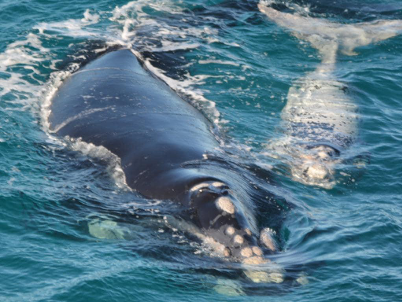
Top Viewpoint: – Gerrin Point Lookout in Bouddi National Park and Bouddi Coastal Walk
Other Viewpoints: – Crackneck lookout Wyrrabalong National Park, Pelican Beach Lookout, Wyrrabalong National Park
Bouddi Coastal Walk within Bouddi National Park is known for its boardwalk and fantastic ocean views. Gerrin Point Lookout is an excellent location for spotting Humpback whales during May through to October and Southern Right whales migrating during in July. The 8km walk from the eastern end of Putty Beach to Macmasters Beach hugs the rugged coastline and gives plenty of opportunities to spot whales on their Pacific Coast migration. The walk is known for the beautiful beaches and birdlife. The 300-hectare national park is one of Australia’s first marine protected areas, one of the reasons why whale migration is so established here.
Crackneck Lookout in the southern end of Wyrrabalong National Park has expansive views over stretches of Bateau Bay and Forresters Beach. This location for local whale watchers allows both sighting of whales and an opportunity to take great photos from the higher vantage point. A coastal walk can also be followed either north to Shelley Beach and The Entrance or south to Forresters Beach. It is a popular spot for hand gliding which adds to the experience as you watch them drifting in the air with a possibility during May to October of seeing whales below them.
Pelican Beach Lookout in the northern end of Wyrrabalong National Parkis a picturesque hotspot to enjoy spotting whales. The lookout has a platform which offers scenic views across the sapphire ocean, the golden sands of Pelican Beach and The Entrance. Nearby bushwalks include Lillypilly loop trail and Redgum trail.
